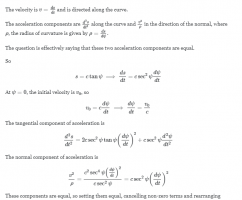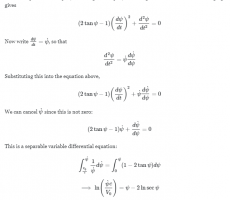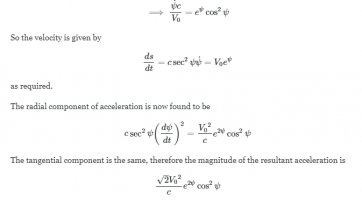Suppose the following figures depicts the catenary \(\displaystyle s= a\cdot \tan{(\psi)}\) where s is arc legth of the curve C and a (in question it is c) is the distance from origin to the dip of the catenary.
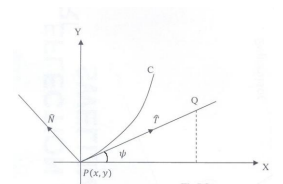
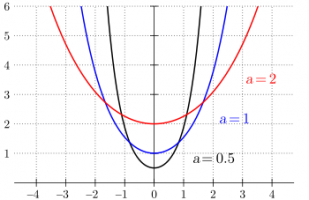
Let \(\displaystyle \vec{r}\) be the position vector at point P. \(\displaystyle \vec{r}= x(s)\hat{i} + y(s)\hat{j} + z(s)\hat{k}\)
\(\displaystyle \hat{T}\) is a unit tangent vector = \(\displaystyle \frac{d\vec{r}}{ds} = \frac{dx}{ds}\hat{i} +\frac{dy}{ds}\hat{j} + \frac{dz}{ds}\hat{k}=\frac{1}{a\cdot\tan^2{(\psi)}}\times\left[ \frac{dx}{d\psi}\hat{i} + \frac{dy}{d\psi}\hat{j} + \frac{dz}{d\psi}\hat{k} \right]\)
Velocity \(\displaystyle \vec{v}\) of the particle at any point of the curve is given by \(\displaystyle \vec{v}=\frac{d\vec{r}}{d\psi}= \frac{d\vec{r}}{ds}\cdot\frac{ds}{d\psi}\)
\(\displaystyle \frac{ds}{d\psi}= a\cdot (1+\tan^2{(\psi)})\) which is the velocity but velocity given in the question is \(\displaystyle V_0e^{\psi}\)
I know \(\displaystyle e^{\psi} = \cosh{(\psi)} + \sinh{(\psi)}\)
\(\displaystyle \vec{A}= \frac{dv}{d\psi}\hat{T} + \frac{v^2}{\rho}\frac{d\hat{T}}{d\psi} \) since radius of curvature is \(\displaystyle \rho= \frac{ds}{d\psi}\)
\(\displaystyle \hat{N}\) is a unit normal vector which is \(\displaystyle \frac{d\hat{T}}{d\psi}\)
Now the question states the angle between acceleration vector(\(\displaystyle \vec{A}\)) and \(\displaystyle \hat{T} \) is equal to the angle between \(\displaystyle \vec{A}\) and \(\displaystyle \hat{N}\)
How to answer this question now?



